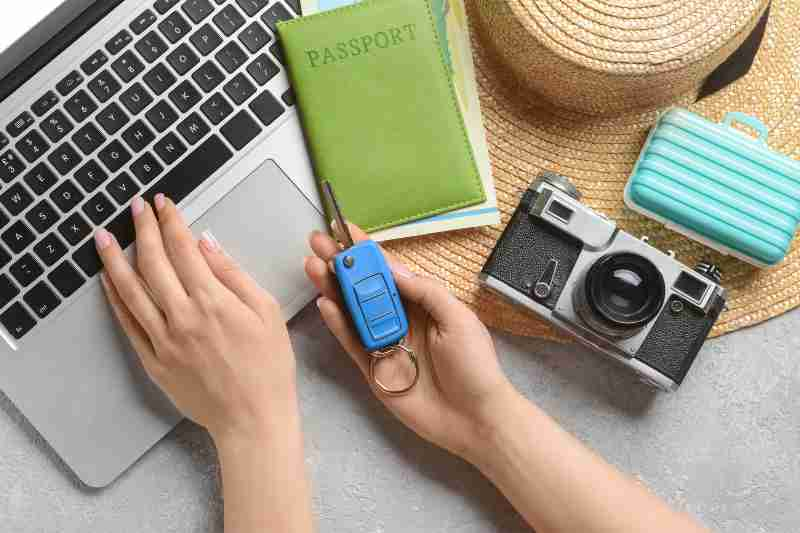Key takeaways
- How to fix an unresponsive or demagnetized key fob? Put it back into your property’s fob programmer.
- Magnetic key fobs work by encoding a unique pattern into millions of magnetic particles. However, these patterns can be easily disrupted by everyday magnetic objects.
- A key fob can be demagnetized through contact with common magnetic items, like TVs, cell phones, or metal clasps on clothing or bags.
- You can purchase key fobs that are powered by other technology, like RFID or Bluetooth. Alternatively, you can embrace keyless access.
- The best keyless access system is ButterflyMX’s swipe-to-open smartphone app.

If you manage access at your property with a key card or key fob system, one thing is certain: eventually, residents start to have technical problems with their fobs. One of the most common is a demagnetized fob.
Here’s a quick guide to help you fix a demagnetized key fob. We also cover reasons why a key fob might become demagnetized and offer alternatives to magnetic fobs.
This post covers:
- How do you fix an unresponsive key fob?
- How do magnetic key fobs work?
- Can key fobs get demagnetized?
- Why a key fob might have been demagnetized
- How to avoid demagnetizing key fobs
- Alternatives to magnetic key fobs
- What is the best keyless access control system?
How do you fix an unresponsive key fob?
To fix an unresponsive key fob, put it back into your property’s fob programmer. That’s it.
Additionally, when you hand the fob or badge back to the resident, gently remind them to keep their magnetic key fob away from sources of magnetic interference to prevent demagnetization from happening again.
If the fob still doesn’t work after that, it might have another problem. This is usually attributed to normal wear and tear. If you’re unsure how to make a key card work again, take a fresh key fob to copy and program to give it the same access permissions as the old one.
How do magnetic key fobs work?
Magnetic key fobs work by encoding credential data into a magnetic stripe present on the fob. This magnetic stripe, or magstripe, is actually made of millions of magnetic particles. When one of these particles is magnetized, it becomes either north-facing or south-facing.
While a choice between two states might not sound like much, fob encoders create unique patterns over the millions of particles on the entire magstripe. So, each time you use your key card machine to program a fob, you change these polarities.
For example, a resident uses their key fob by holding it up to a credential reader. Readers scan information stored in a fob by sending out a quick burst of voltage and recording what comes back.
Then, if the information the reader receives matches the credentials in the reader’s internal database, the reader considers the card valid and triggers the lock to open.
Can key fobs get demagnetized?
Unfortunately, yes, key fobs can get demagnetized — and it happens often.
While Weigand magnetic access is secure, it depends on those magnetic particles staying in the same configuration. And with so many sources of magnetic force in the world, it’s common for particles to accidentally reverse their polarities. As a result, they render the whole pattern illegible.
Why a key fob might have been demagnetized
A magnetic key fob can become demagnetized due to exposure to an outside magnetic force that wipes its data.
Sometimes, a fob might come close to a battery-powered electromagnetic device. As a result, it may have its data wiped that way. Other times, proximity to a simple kitchen magnet is enough to demagnetize a fob.
Common items that might demagnetize key fobs include:
- Credit cards
- Cell phones
- Airport security scanners
- MRI machines
- Magnetic clasps on purses or wallets
- Clothing security tags
Credit cards
Credit cards and key fobs use similar technology — both contain a magnetic stripe that stores data. So, when a key fob and a credit card come in close contact with one another, one can disrupt the other card’s magnetic field.
As a result, having your key fob in close proximity to the credit card in your wallet can lead to the key fob’s data being erased.
Cell phones
Smartphones are a common source of magnet exposure because magnets are an invisible part of every smartphone.
Although modern cell phones are not very likely to demagnetize a key fob card, they do emit electromagnetic fields. Consequently, placing your key card very close to a powerful electromagnetic source like a turned-on and actively transmitting cell phone could theoretically cause issues.

Airport security scanners
Airport security scanners use strong magnetic fields to detect metal objects. So, when you pass through these scanners, your key fob is subjected to these magnetic fields. As a result, key fob cards can become inoperable due to the magnetic stripe being demagnetized by prolonged exposure to these scanners.
MRI machines
MRI (Magnetic Resonance Imaging) machines are extremely powerful devices that use strong magnetic fields and radio waves to create detailed images of the inside of the body. So, they can impact magnetically sensitive items, including key fobs.
When exposed to the intense magnetic fields inside an MRI machine, the magnetic particles on a key fob card can become disrupted. This causes the data to be erased or corrupted.
Magnetic clasps on purses or wallets
A magnetic clasp on a purse or wallet is typically not strong enough to demagnetize a key fob under normal circumstances. However, if the magnetic clasp is exceptionally strong, or if the key card is in direct and prolonged contact with the magnet, there is a slight risk of demagnetization.
Clothing security tags
Clothing security tags contain strong magnets that can potentially demagnetize and render a key card ineffective when in direct contact.
How to avoid demagnetizing key fobs
The best way to avoid demagnetizing key fobs is keeping them away from magnetic objects.
Additionally, you can place the key fob in a plastic sleeve or its own wallet holder to prevent it from coming into contact with other magnetized cards.
Watch how ButterflyMX works:
Alternatives to magnetic key fobs
Are you tired of re-magnetizing your residents’ fobs? Luckily, there’s a solution.
In fact, you can still reap the benefits of electronic access control without relying on magstripes.
Instead of dealing with magnetic fobs, you might:

1. Choose fobs that use a different technology
Different technologies that aren’t as vulnerable to interference can power key card systems. For example, buy RFID or Bluetooth fobs that exchange data with readers using radio waves instead of magnetization. So, if you still want to hand out key fobs to your residents, it’s best to choose one of these.
With an RFID or Bluetooth fob, magnetic interference might not be an issue anymore. However, you do open yourself up to a host of other complications.
In some cases, these newer fobs come with their own batteries and transmission capabilities. They’re more sophisticated, but you might have to spend more money on an RFID fob than a magnetic fob.
Not to mention, all credential-based access control systems carry the risk of credentials being lost or stolen.
2. Invest in keyless access control
Even if a fob is technologically reliable, you’ll run into problems if residents use them every day. You still might need to send them out for repairs. And because fobs are so small, your residents might lose them — requiring you to constantly order and program replacements.
Luckily, today’s best access control systems offer credential solutions that free residents from carrying keys at all.

What is the best keyless access control system?
The best keyless access control system is ButterflyMX.
You may be looking to augment fob access with alternative ways to open doors or gates. Or, maybe you’re looking to bypass fobs entirely. Whatever your goal, your best option is the ButterflyMX access control system.
ButterflyMX’s ecosystem of intercoms, keypads, elevator controllers, and more serves over 10,000 buildings around the world.
Instead of dealing with fobs that are easily lost and demagnetized, save money on fob replacement costs by empowering your residents to open doors with their phones.
With ButterflyMX, access is as easy as opening an app on a resident’s smartphone and swiping-to-open.
However, if you’re still interested in keeping fob access, we gladly offer that too. Our network of integrators and installers can install our seamless fob system. Or, they can save you installation costs by integrating our system into your existing one.







